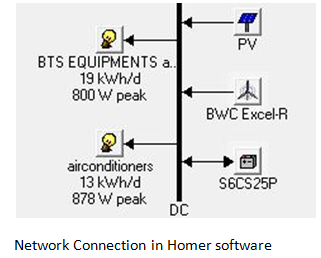




Homer Model Description
HOMER software is a computer modelling tool that simplifies the task of designing distributed energy generation systems. Both ON and OFF-grid scenarios were used to evaluate the economic and technical feasibility of the technology options and also variations in technology costs and energy resource availability. This led to mapping the best possible combination of renewable energy systems for telecommunication stations based in rural parts of India and Nigeria.
For the proposed renewable energy system with a load demand of 32kWh/d the following wind turbines were considered:
- Generic 3kW DC wind turbine with a cut - in speed of 4m/s
- BWC Excel-R 7.5 kW DC wind turbine with a cut - in speed of 3m/s
The capital, replacement and maintenance costs for one unit of wind turbine defined were $9,000, $7,000 and $100/year for the 3kW wind turbine and $18,000, $15,000 and $100/year for the 7.5kW turbine respectively.
The PV modules used were connected in a series and parallel configuration in order to achieve a 48V DC output which could be fed directly into the telecoms equipment. The efficiency of the PV module was 13.4% with nominal operating cell temperature of 47 degrees Celsius, a derating factor of 80% and a ground reflectance of 40%.
The capital, replacement and maintenance cost of PV modules was taken as $2 / W, $1.8 /W and $100/kW/year respectively.
The Photo Voltaic system was considered to have no tracking system for the purpose of the study in order to determine the worst case resource from each of the sites.
The lifetime of both the wind turbine and PV modules were defined to be 20 years for the focus of this study while DC type sources were used in order to eliminate electrical energy conversion losses.
The battery bank used for storage was a 6V Surrete battery 6CS 25P connected as 8 strings in series to achieve a DC bus voltage of 48V and 6 strings in parallel to achieve a nominal power capacity of 300kWh making a total of 48 batteries.
The capital cost of one Surrete battery is $1,145 with a replacement cost of $1,000. The battery has nominal capacity of 1156Ah and a float life of 12 years. The battery bank is used as a backup and it also helps to maintain a constant voltage across the load.
The 3 and 7.5kW wind turbine were selected as these were the only viable options that met the power needs at a reasonable energy supply and cost.
In the simulations, we endeavored to keep the battery state of charge (SOC), at any point in time at a minimum of 50% in order to increase the shelf life of the battery.
When fully charged, the battery storage system can supply electrical power for 5 days without re-charging before reaching 50% SOC. This was done in order to maintain uninterrupted power supply to the equipment. The rate of discharge of the battery at maximum load is about 8% per day. This once again ensures a secure and reliable power supply.
From all of the possible combination of renewable energy sources, an excess of about 20% power supply is guaranteed in every location simulated in order to give room for future station expansion.
As a secondary back-up power source, a 15kVA Diesel generator was adopted in the simulations, with an annual consumption of 17,700 liters. The capital cost, replacement cost and operation-maintenance costs for the DG are $13,000, $13,000 and $ 2.5/hr respectively while the cost of diesel used for the sensitivity analysis are $1 / liter and $ 1.2 / liter taking into account a present day cost of $ 1/liter.
